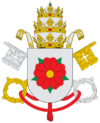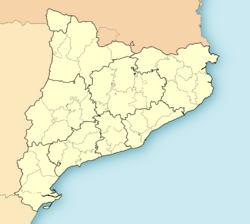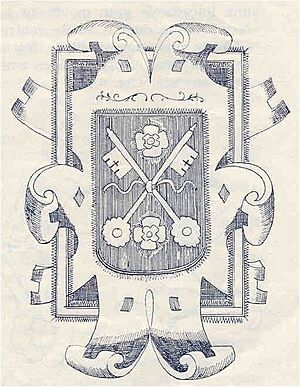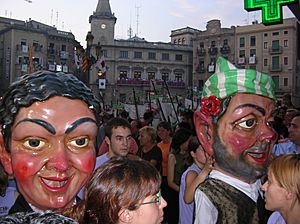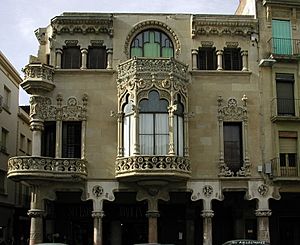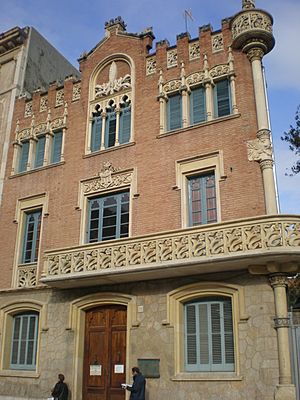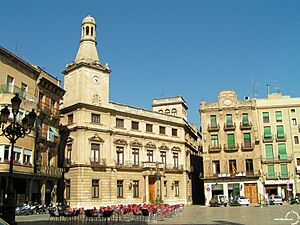Reus facts for kids
Quick facts for kids
Reus
|
|||
|---|---|---|---|
|
Municipality
|
|||
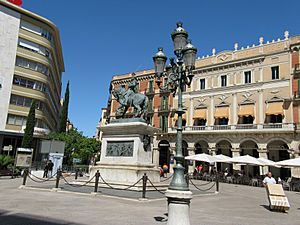
Monument to Joan Prim
|
|||
|
|||
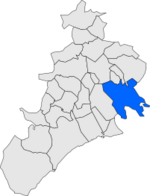
Location in Baix Camp county
|
|||
| Sovereign state | |||
| Community | |||
| Region | Camp de Tarragona | ||
| County | Baix Camp | ||
| Province | Tarragona | ||
| Area | |||
| • Total | 52.8 km2 (20.4 sq mi) | ||
| Elevation | 134 m (440 ft) | ||
| Population
(2018)
|
|||
| • Total | 103,477 | ||
| • Density | 1,959.8/km2 (5,076/sq mi) | ||
| Demonym(s) | Reusenc, -ca | ||
| Climate | Csa | ||
Reus is an important city in Catalonia, Spain. It is the capital of Baix Camp county. For a long time, Reus was famous for making wines and spirits. It became even more important during the Phylloxera plague, which affected vineyards across Europe.
Today, Reus is known for its busy shops and businesses. It's also a popular spot for rock-climbing. Many people know Reus as the birthplace of the famous architect Antoni Gaudí.
Contents
What Does the Name Reus Mean?
The name Reus has an interesting history. One idea is that it comes from a Latin word meaning "convict prisoners." This would suggest it was once a Roman prison.
However, the most popular idea today is that the name comes from an old Celtic word. This word, red or redis, likely meant "a place on the way" or "a place where roads meet." This makes sense because Reus was an important crossroads.
A Look Back at Reus's History
How Reus Began
Around the year 1150, a person named Robert d'Aguiló helped bring people back to the Reus area. Later, in 1154, the archbishop of Tarragona gave part of Reus to Bertran de Castellet. Bertran was asked to build a church there.
The city was first called Redis or Reddis. In 1183, the local leader, Bernat de Bell-lloc, officially made Reus a town. He gave people rights to own houses and gardens. Even though Reus was a town, it still had to follow the rules of the archbishop of Tarragona.
Popes and Power in Reus
In 1305, the people of Reus protested against Archbishop Rodrigo Tello. He wanted them to pay for rebuilding the walls of Tarragona. The king of Aragon then gave Reus the right to hold a market every Monday.
Later, a leader called the camerlengo, Pere Roger de Belfort, had a disagreement with the Archbishop López de Ayerbe. The Archbishop even sent an army to Reus! But Pere Roger de Belfort was the nephew of Pope Clement VI. He convinced the Pope to make peace.
Pere Roger de Belfort later became Pope Gregory XI. He kept his connection to Reus. He even added roses from his family's coat of arms to Reus's city symbol. That's why the city's coat of arms has a crown, a papal tiara, and the keys of St. Peter.
Wars and Changes
During the Reapers' War in the 1600s, Reus lost many houses and people. The city was even declared an "enemy of the fatherland" for not helping enough in the war. French soldiers also took over the city for a time.
Reus was loyal to Philip V of Spain at first. But in 1705, it switched sides to support Archduke Charles. Archduke Charles even visited the town in 1706. The city changed hands a few times during these wars. Finally, in 1713, the supporters of Philip V took control for good.
Growing Strong in the 1700s
The 1700s were a time of huge growth for Reus. It became the second-largest city in Catalonia. The city walls were taken down in 1766 to make room for expansion.
Reus became very important for trading textiles (fabrics) and liquor. It was one of the top three centers for liquor trade in Europe, along with London and Paris. People even had a saying: "Reus, Paris and London!" This shows how important Reus was. At this time, Reus had consulates (offices for foreign governments) from many countries around the world.
The 1800s and 1900s
In 1854, the Reus Gas Company was started. Two years later, a railway line connected Reus to Tarragona. In 1895, a disease called phylloxera destroyed many vineyards in the Reus area. Because of this, many farmers started growing hazelnuts instead.
In 1931, Reus voted to support the Second Spanish Republic. However, during the Spanish Civil War, Francisco Franco's forces bombed the city. They took control of Reus in January 1939. Franco's rule lasted until his death in 1975. After that, Reus had its first democratic mayor, Carles Martí Massagué.
Reus's People and Population
For a long time, Reus was the second-largest city in Catalonia. In 1787, it had about 14,440 people. By 1860, this grew to 27,257. Other cities like Tarragona and Lleida grew faster for a while.
Since the 1930s, Reus's population has grown a lot. In 1960, there were 41,014 people. By the end of 2008, it had grown to 108,100. Many new residents have moved to Reus, especially from Marrakesh.
Here's how the population has changed over the years:
| 1900 | 1930 | 1950 | 1970 | 1986 | 2006 | 2011 |
|---|---|---|---|---|---|---|
| 26,681 | 31,299 | 35,950 | 59,904 | 81,145 | 101,767 | 106,709 |
Weather in Reus
Reus has a Hot-summer Mediterranean climate. This means it has hot, dry summers and mild, wet winters. The weather is usually pleasant for most of the year.
| Climate data for Reus Airport (REU) weather station (1981–2010) (between Reus - 3 km (1.86 mi) and Tarragona - 7 km (4.35 mi)) | |||||||||||||
|---|---|---|---|---|---|---|---|---|---|---|---|---|---|
| Month | Jan | Feb | Mar | Apr | May | Jun | Jul | Aug | Sep | Oct | Nov | Dec | Year |
| Record high °C (°F) | 24.7 (76.5) |
25.0 (77.0) |
27.7 (81.9) |
30.2 (86.4) |
32.8 (91.0) |
36.8 (98.2) |
37.4 (99.3) |
39.8 (103.6) |
33.8 (92.8) |
32.5 (90.5) |
28.8 (83.8) |
22.6 (72.7) |
39.8 (103.6) |
| Mean daily maximum °C (°F) | 14.1 (57.4) |
14.9 (58.8) |
17.1 (62.8) |
19.0 (66.2) |
22.2 (72.0) |
26.3 (79.3) |
29.3 (84.7) |
29.4 (84.9) |
26.3 (79.3) |
22.3 (72.1) |
17.5 (63.5) |
14.6 (58.3) |
21.1 (70.0) |
| Daily mean °C (°F) | 9.0 (48.2) |
9.7 (49.5) |
11.9 (53.4) |
13.8 (56.8) |
17.2 (63.0) |
21.2 (70.2) |
24.2 (75.6) |
24.6 (76.3) |
21.5 (70.7) |
17.5 (63.5) |
12.6 (54.7) |
9.7 (49.5) |
16.1 (61.0) |
| Mean daily minimum °C (°F) | 3.9 (39.0) |
4.5 (40.1) |
6.6 (43.9) |
8.6 (47.5) |
12.1 (53.8) |
16.1 (61.0) |
19.1 (66.4) |
19.7 (67.5) |
16.6 (61.9) |
12.7 (54.9) |
7.6 (45.7) |
4.7 (40.5) |
11.1 (52.0) |
| Record low °C (°F) | −7.6 (18.3) |
−8.0 (17.6) |
−5.4 (22.3) |
1.0 (33.8) |
3.6 (38.5) |
7.4 (45.3) |
10.5 (50.9) |
10.8 (51.4) |
5.5 (41.9) |
0.2 (32.4) |
−4.0 (24.8) |
−7.5 (18.5) |
−8.0 (17.6) |
| Average precipitation mm (inches) | 29 (1.1) |
28 (1.1) |
28 (1.1) |
37 (1.5) |
54 (2.1) |
25 (1.0) |
15 (0.6) |
42 (1.7) |
77 (3.0) |
75 (3.0) |
53 (2.1) |
36 (1.4) |
500 (19.7) |
| Average precipitation days (≥ 1 mm) | 4 | 4 | 4 | 5 | 5 | 3 | 2 | 4 | 5 | 6 | 4 | 4 | 50 |
| Average relative humidity (%) | 70 | 68 | 67 | 66 | 66 | 63 | 63 | 66 | 70 | 73 | 72 | 72 | 68 |
| Mean monthly sunshine hours | 157 | 162 | 197 | 222 | 251 | 274 | 306 | 265 | 209 | 182 | 157 | 145 | 2,527 |
| Source: Agencia Estatal de Meteorología | |||||||||||||
Reus's Economy
In the 1800s and 1900s, Reus became famous for making vermouth and other liquors. It had over 30 companies producing these drinks. Even today, Reus is home to major vermouth makers like Yzaguirre, Iris (Muller), Miró, and Fot-Li.
Fun Festivities in Reus
The biggest celebration in Reus is Sant Pere on June 29. It's a very popular festival for tourists. A special part of this festival is the tronada. This is a series of small fireworks and loud crackers arranged in a line around the main square. It ends with a big display in front of the city hall.
Another important festival is Mare de Déu de la Misericòrdia on September 25. Reus also celebrates Carnival with parades and costumes. Many neighborhoods have their own smaller parties too.
Besides these, Reus hosts many other festivals:
- Cos is a festival all about mime performances.
- El Trapezi is a festival that features amazing circus shows.
- Every two years, the city holds the Biennals Internacionals de Fotografia Medalla Gaudi. This exhibition shows beautiful photos from artists worldwide. They often buy some of the art for the city's collection.
Cool Places to See in Reus
Modernist Buildings in Reus
Reus is full of beautiful Catalan modernist buildings. Even though Antoni Gaudí was born here, he didn't design any buildings in Reus. However, many of his friends and colleagues did! These include famous architects like Lluís Domènech i Montaner, Pere Caselles i Tarrats, and Pere Domènech Roura.
Some famous modernist buildings you can see are:
- Casa Navàs, designed by Lluís Domènech i Montaner (1901–1908)
- Casa Rull, also by Lluís Domènech i Montaner (1901)
- Casa Gasull, another one by Lluís Domènech i Montaner (1910–1912)
- Institut Pere Mata, a large hospital complex by Lluís Domènech i Montaner (1899–1919)
- Casa Pinyol, by Pere Caselles i Tarrats (1910)
- Escoles Prat de la Riba, by Pere Caselles i Tarrats (1911)
Other Interesting Sights
- Castell del Cambrer
- Campanar de Reus (Bell Tower)
- Town Hall
- Palau Bofarull
- Centre de Lectura (Reading Center)
- Museu Salvador Vila-seca (Museum)
- Teatre Fortuny (Theater)
- Gaudí Centre (A museum dedicated to Antoni Gaudí)
Sports in Reus
Reus has a well-known roller hockey team called Reus Deportiu. They play in the top league in Spain, the OK Liga.
The city also used to have a professional association football team, CF Reus Deportiu.
The Barcelona Dragons, an American football team, plan to play their home games at the local Municipal Stadium.
Visiting Reus as a Tourist
In recent years, more and more people have been visiting Reus. Many come for summer holidays or winter sun in the Costa Daurada region. Tourists from Russia, France, and Holland are among the most frequent visitors.
Reus is very close to the popular resort town of Salou. It's also near PortAventura World, one of Europe's biggest theme parks. Tour companies offer trips to Reus from nearby tourist spots like Salou, La Pineda, and Cambrils.
You can find different places to stay in Reus, from small hotels and hostels to larger hotels.
Reus Airport has become a hub for low-cost flights from many European cities and North Africa. It also handles charter flights, especially from the United Kingdom. If your destination isn't served by Reus Airport, Barcelona Airport is another option nearby.
Reus's Flag
The first flag of Reus was used from 1774 to 1943. It was dark red with the city's coat of arms in the middle.
In 1943, the flag was changed. The color red was seen as being linked to the losing side of the civil war. So, the new flag became white, matching the silver color of the city's historic rose emblem. The rose on the flag has been updated a few times since then.
The current rose design is taken from the city's official emblem. This means the flag is also likely official.
Famous People from Reus
Many notable people were born in Reus, including:
- Antònia Abelló (1913-1984), a political activist, journalist, and feminist.
- Joan Prim i Prats (1814–1870), a military general and politician.
- Roseta Mauri i Segura (1849–1923), a famous ballerina and dance teacher.
- Antoni Gaudí (1852–1926), the world-renowned architect.
- Isaac Cuenca (born 1991), a football player.
- Sergi Roberto (born 1992), another football player.
- Andreu Buenafuente (born 1965), a well-known late-night show host.
Twin Cities
Reus is twinned with several cities around the world. This means they have special friendly relationships and often share cultural exchanges.
 Bahía Blanca, Argentina, since 1994
Bahía Blanca, Argentina, since 1994 Hadžići, Bosnia and Herzegovina, since 1995
Hadžići, Bosnia and Herzegovina, since 1995 Astorga, Spain, since 1998
Astorga, Spain, since 1998 Amgala, Sahrawi Arab Democratic Republic, since 2000
Amgala, Sahrawi Arab Democratic Republic, since 2000 Boyeros, Cuba, since 2000
Boyeros, Cuba, since 2000 Gandia, Spain, since 2008
Gandia, Spain, since 2008
Images for kids
-
Francisco Franco in Reus, 1940
See also
 In Spanish: Reus para niños
In Spanish: Reus para niños



